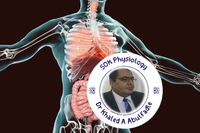admin
Admin

عدد المساهمات : 9700
تاريخ التسجيل : 06/08/2009
 |  موضوع: MCQs with their answers on respiratory physiology موضوع: MCQs with their answers on respiratory physiology  الخميس يونيو 02, 2011 8:49 pm الخميس يونيو 02, 2011 8:49 pm | |
| Indicate the best answer or completion.
1. Due to polio, a patient suffers total paralysis of his intercostal muscles. For this patient, which of the following values would still be expected to be essential normal?
A. inspiratory reserve volume (IRV)
B. expiratory reserve volume (ERV)
C. total lung capacity (TLC)
D. vital capacity (VC)
E. none of the above
2. A child with normal lung volumes for his age (TLC = 2.5 liters, VC = 2.0 liters, ERV = 0.5 liters) would expected to have an FEV1 (one-second forced expired volume) in the range of
A. 0.5-1.0 liters
B. 1.0-1.6 liters
C. 1.6-2.0 liters
D. 2.0-2.5 liters
E. 2.5-3.0 liters
3. Contraction of the abdominal muscles is important in
A. normal (quiet) inspiration
B. forced (maximum) inspiration
C. normal (quiet) expiration
D. forced (maximum) expiration
E. none of the above
4. Alveolar surfactant acts to increase pulmonary
A. surface tension
B. compliance
C. airway resistance
D. blood flow
E. both B and D above
5. Administration of an agonist for which of the following autonomic receptors would be expected to cause airway resistance to decrease?
A. muscarinic-cholinergic
B. nicotinic-cholinergic
C. alpha-adrenergic
D. beta-adrenergic
E. histaminic
6. In emphysema, which of the following would be expected to be below normal (less positive or more negative than normal)?
A. airway resistance
B. lung compliance
C. intrapleural pressure
D. FEV1
E. B, C, and D above
7. At which of the following times in the respiratory cycle is the intrapleural pressure most negative?
A. just after the beginning of inhalation (inspiration
B. just before the end of inhalation
C. just after the beginning of exhalation (expiration)
D. just before the end of exhalation
E. any of the above, since the intrapleural pressure is constant during the normal respiratory cycle
The following questions refer to measurements taken on a male subject, age 25, at rest. Indicate whether the value given for a particular measurement is above the value that would be expected for a normal subject, below normal, or contained within the normal range.
8. Residual volume of 2.5 liters
A. above normal
B. below normal
C. within the normal range
9. Intrapleural pressure with relaxed respiratory muscles of -5 cmH2O
A. above normal (less negative than normal)
B. below normal (more negative than normal)
C. within the normal range
10. PEF (peak expired flow rate) of 250 liters/minute
A. above normal (less negative than normal)
B. below normal (more negative than normal)
C. within the normal range
===========================
Answer
===========================
[ندعوك للتسجيل في المنتدى أو التعريف بنفسك لمعاينة هذه الصورة]
       | |
|
admin
Admin

عدد المساهمات : 9700
تاريخ التسجيل : 06/08/2009
 |  موضوع: رد: MCQs with their answers on respiratory physiology موضوع: رد: MCQs with their answers on respiratory physiology  الخميس يونيو 02, 2011 9:08 pm الخميس يونيو 02, 2011 9:08 pm | |
| | |
|
admin
Admin

عدد المساهمات : 9700
تاريخ التسجيل : 06/08/2009
 |  موضوع: رد: MCQs with their answers on respiratory physiology موضوع: رد: MCQs with their answers on respiratory physiology  الخميس يونيو 02, 2011 9:18 pm الخميس يونيو 02, 2011 9:18 pm | |
| | |
|
